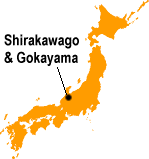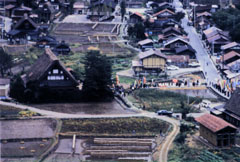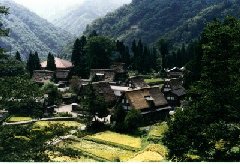

 |
||

|
An Architectural Device to Live with Harsh
Nature
 In the three villages of Ogimachi in Gifu Prefecture, Ainokura and Suganuma in Toyama Prefecture, there remain groups of historical farmhouses with unique architectural character, the "Gassho-style" houses. The three villages, all of which are farm villages located in a steep mountainous area, retain much of the historic character of the village landscape as well as the surrounding natural environment. In terms of architectural history, the Gassho-style house is one of the most important farmhouse types in Japan, due to its rarity and uniqueness, as well as the fact that the surviving examples are clustered together in entire villages. The Gassho-style houses were built between the 17th century and the beginning of the 20th century. There used to be some 1,800 Gassho-style houses in 93 villages, but now just 150 remain, more than half of which are in the above three villages. These houses are much larger than most other regions' farmhouses, and the roof is a tall, steeply-sloped thatched gable roof with an angle of about 60 degrees. This roof shape, which looks like one's hands put together with the palms facing inward, is the origin of the name of the architectural style, "Gassho", which means to join one's hands in prayer. As it snows heavily in winter in this region, this steeply-sloped roof helps the snow to slip off and prevents the house from being crushed. The structural space inside is typically divided into three or four levels which were traditionally used as a work space, for example, for raising silkworms and making washi paper. Such in-house works during winter provided an important source of income in those remote, mountainous areas with limited agricultural products. The openings in the large gable ends for natural lighting and ventilation of the attic space add uniqueness to the building's appearance.  The Gassho-style architecture was first introduced to the West in 1939 by Bruno Taut, a German architect who stayed in Japan from 1933 to 1936 and traveled widely to study Japanese architecture. Since then, its uniqueness and importance has been recognized world-wide. In 1995, the three villages of Ogimachi, Ainokura, and Suganuma were registered on UNESCO's World Heritage list. Photos: (Top) The Gassho-style farmhouses in Shirakawa-go (Gifu Prefecture); (middle) the village in Gokayama area (Toyama Prefecture). Unauthorized reproduction of the
photos in this page is prohibited.
Related Links: |
|

